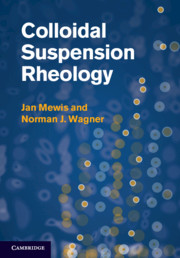Book contents
- Frontmatter
- Contents
- Preface
- General list of symbols
- Useful physical constants and values
- 1 Introduction to colloid science and rheology
- 2 Hydrodynamic effects
- 3 Brownian hard spheres
- 4 Stable systems
- 5 Non-spherical particles
- 6 Colloidal attractions and flocculated dispersions
- 7 Thixotropy
- 8 Shear thickening
- 9 Rheometry of suspensions
- 10 Suspensions in viscoelastic media
- 11 Advanced topics
- Index
- References
4 - Stable systems
Published online by Cambridge University Press: 05 December 2011
- Frontmatter
- Contents
- Preface
- General list of symbols
- Useful physical constants and values
- 1 Introduction to colloid science and rheology
- 2 Hydrodynamic effects
- 3 Brownian hard spheres
- 4 Stable systems
- 5 Non-spherical particles
- 6 Colloidal attractions and flocculated dispersions
- 7 Thixotropy
- 8 Shear thickening
- 9 Rheometry of suspensions
- 10 Suspensions in viscoelastic media
- 11 Advanced topics
- Index
- References
Summary
Introduction
The previous chapter considered stable suspensions of Brownian hard spheres. As noted, such dispersions are difficult to realize in practice as the ubiquitous van der Waals attractive forces necessitate some explicit method of imparting stability. These stabilizing forces can be of electrostatic and/or steric origin, as discussed in Chapter 1. When the interparticle interaction is repulsive at all but short separations and the barrier to aggregation sufficiently large, the suspension is kinetically (sometimes referred to as colloidally) stable. Under these conditions, the microstructure and rheology have many similarities to the case of Brownian hard spheres, such that mapping of the rheology onto hard sphere behavior is possible. However, under some conditions the microstructure and the rheology can differ strongly from that of Brownian hard spheres, as will also be discussed in this chapter.
In contrast to the hard sphere potential, the repulsive forces considered here decrease gradually with increasing interparticle distance. Hence, they are “softer” than hard sphere interactions (see Figures 1.7 and 1.8, for example). As the interparticle forces are conservative, they can store energy. Such stored energy will lead to additional elasticity in the colloidal dispersion, affecting both the shear viscosity and elastic modulus. As discussed in Chapters 1 and 3, the strength of the Brownian force scales with kBT/a, which sets the scale for the elasticity of Brownian hard sphere suspensions. Imparting a significant electrostatic (charge), steric (polymer), or electrosteric stabilizing force can lead to much greater repulsive forces and, hence, larger elastic moduli. Furthermore, these forces can act over a significant range and, thus, can drive crystallization and glass formation at much lower particle concentrations than those required for Brownian hard spheres. As the suspension microstructure and rheology will depend on the relative balance between hydrodynamic, Brownian, and repulsive forces, we can anticipate a more complex rheology for dispersions consisting of particles stabilized with interparticle repulsions of finite extent.
- Type
- Chapter
- Information
- Colloidal Suspension Rheology , pp. 122 - 154Publisher: Cambridge University PressPrint publication year: 2011



